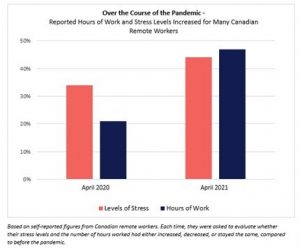The challenging complexities of our hyper-connected world have only been magnified during the COVID pandemic, making the importance of a beneficial life-work balance even greater.
Our connectivity has only increased with a blurring of lines between home and work, and the increases in speed of our 5(soon to be 6)G, the metaversed online world and the many digital devices we use to interact with it.
Confirming the accumulating negative impacts of the pandemic, a new survey from ADP Canada and Angus Reid shows that many Canadian workers are paying a “COVID Tax” – the additional hours they’re working since the start of the pandemic.

Canadian remote workers reported an increase in stress levels and worked hours since the beginning of the pandemic. (CNW Group/ADP Canada Co.)
That’s why many legal jurisdictions here and in Europe have implemented what are called “right to disconnect” laws.
They are trying to address trends in the workplace that can negatively impact worker performance and satisfaction.
Here in Canada, provincial legislators are reviewing various “right to disconnect” ideas and proposals. It is not to say there is a right to disconnect: rather, there is a policy covering the expected parameters of the job, on- or offline.
In Ontario, the government has tabled the Working for Workers Act, 2021 (or WWA), with significant implications for employment standards and the workplace.
Ontario wants to keep labour laws at “pace with the acceleration of new technology, automation, and remote work,” Monte McNaughton, Minister of Labour, Training and Skills Development explained.
Employers with 25 workers or more should develop disconnecting from work policies. They could include, for example, expectations about response time for emails and encouragement for employees to turn on out-of-office notifications when they aren’t working.

Employers should regard health and safety responsibilities for employees working from home the same as for any other type of employee. Open Access Image: Volodymyr Melnyk.
Work-from-home policies should define the expectations of both worker and employer regarding job scheduling and performance assessments.
That’s one way to address some concerning workplace survey results that show:
- 61 per cent of workers say they need at least eight hours a day to get their job done, and
- 52 per cent never completely disconnect from work because they feel obligated to respond to messages and requests immediately.
“Technology has increasingly blurred work-life balance, a situation exacerbated during COVID-19 as people turned their home into their job site, with workers expected to be reachable and available 24/7,” said Unifor National President Jerry Dias when responding to the new laws. “This legislation is a first step towards establishing clearer boundaries between personal and work time to improve both physical and mental health outcomes for working Ontarians, especially for non-union workers who do not have the protection of a collective agreement.”
As mentioned, significant changes in our workday have already been blurring those boundaries.
Additional research by the cybersecurity company NordLayer shows the average time Canadian workers spent logged onto a computer increased during the pandemic. But should the long-touted end of the eight-hour workday mean the onset of a nine- to 11-hour workday?
Another increase points to a less obvious but nevertheless equally concerning work trend: the number of Internet searches for advice about ailments caused by tech use is way up. According to a report from Harmony Healthcare IT, there’s been a more than 75 per increase in searches related to computer-related eye strain and a 142-per-cent increase in searches related to back pain from working at a computer.
The home office it seems can be less safe, less ergonomically healthy, than the office office.

Although some say the right to disconnect would be difficult enforce, special arrangement could be implemented in specific industries, or with specific workforces.
As efforts to make the domestic work environment as safe and secure and protected as the company work environment, there are concerns that the right to disconnect policy might be abused.
But the right to disconnect is not about giving workers the right to “ignore work-related messages when at home”.
It is not about undercutting or dismissing other work-related agreements and understandings, such as flex time or split shifts.
It is about getting the worker and the employer to agree on work-from-home parameters. Ontario’s WWA clearly states that employers here must write out the employee’s “right to disconnect” and the implication is that is done before work starts.
It is clear, too, that the time to “not engag[e] in work-related communications, including emails, telephone calls, video calls or the sending or reviewing of other messages” takes place after defined work hours.
The Act received Royal Assent on December 2, 2021. It:
- Requires that employers with 25 or more employees institute a written disconnect from work policy;
- Prohibits employers from entering into non-compete agreements with employees, with limited exceptions; and
- Requires that temporary help agencies and recruiters obtain a license to operate in Ontario with a prohibition against a recruiter or employer charging fees to foreign nationals.
Employers have six months to comply with the requirements for a written policy on disconnecting from work. Regulations are expected to come into effect in the future which will prescribe the terms required to be contained in the policy.
-30-




An advisory group looking at how Canada should deal with the right to disconnect after work hours was split on whether the country should adopt a legislative requirement for workplaces.
A final report released February 10, 2022, by the Right to Disconnect Advisory Committee said unions and non-governmental organizations want the country to use legislation to force workplaces to establish a right to disconnect.
Employers consulted by the government favoured a voluntary approach because they felt the Canada Labour Code already has clear guidelines around hours of work and appropriate compensation for after-work tasks.
The Government says it is considering all recommendations made by the Committee and intends to bring forward a plan for a right-to-disconnect policy in Canada.